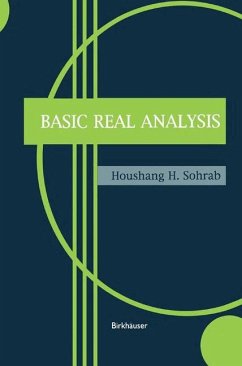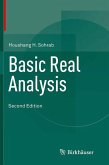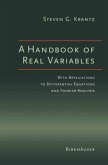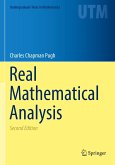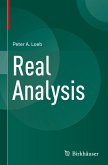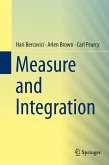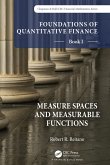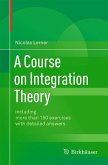One of the bedrocks of any mathematics education, the study of real analysis introduces students both to mathematical rigor and to the deep theorems and counterexamples that arise from such rigor: for instance, the construction of number systems, the Cantor Set, the Weierstrass nowhere differentiable function, and the Weierstrass approximation theorem. Basic Real Analysis is a modern, systematic text that presents the fundamentals and touchstone results of the subject in full rigor, but in a style that requires little prior familiarity with proofs or mathematical language.
Key features include:
_ A broad view of mathematics throughout the book
_ Treatment of all concepts for real numbers first, with extensions to metric spaces later, in a separate chapter
_ Elegant proofs
_ Excellent choice of topics
_ Numerous examples and exercises to enforce methodology; exercises integrated into the main text, as well as at the end of each chapter
_ Emphasis on monotone functions throughout
_ Good development of integration theory
_ Special topics on Banach and Hilbert spaces and Fourier series, often not included in many courses on real analysis
_ Solid preparation for deeper study of functional analysis
_ Chapter on elementary probability
_ Comprehensive bibliography and index
_ Solutions manual available to instructors upon request
By covering all the basics and developing rigor simultaneously, this introduction to real analysis is ideal for senior undergraduates and beginning graduate students, both as a classroom text or for self-study. With its wide range of topics and its view of real analysis in a larger context, the book will be appropriate for more advanced readers as well.
Key features include:
_ A broad view of mathematics throughout the book
_ Treatment of all concepts for real numbers first, with extensions to metric spaces later, in a separate chapter
_ Elegant proofs
_ Excellent choice of topics
_ Numerous examples and exercises to enforce methodology; exercises integrated into the main text, as well as at the end of each chapter
_ Emphasis on monotone functions throughout
_ Good development of integration theory
_ Special topics on Banach and Hilbert spaces and Fourier series, often not included in many courses on real analysis
_ Solid preparation for deeper study of functional analysis
_ Chapter on elementary probability
_ Comprehensive bibliography and index
_ Solutions manual available to instructors upon request
By covering all the basics and developing rigor simultaneously, this introduction to real analysis is ideal for senior undergraduates and beginning graduate students, both as a classroom text or for self-study. With its wide range of topics and its view of real analysis in a larger context, the book will be appropriate for more advanced readers as well.
"Students who find Goffman's 'Real Functions' (1953), Halmos's 'Measure Theory' (1950), Hewitt and Stromberg's 'Real and Abstract Analysis' (1965), Lang's (1969) or Royden's 'Real Analysis' (1963), or Rudin's (1973) or Yosida's 'Functional Analysis' (1965) to be too hard, or too easy, may find Sohrab's presentation just right. Problems and exercises abound; an appendix constructs the reals as the Cauchy (sequential) completion of the rationals; references are copious and judiciously chosen; and a detailed index brings up the rear. . . . Recommended."
-CHOICE
"This book is intended as a text for a one-year course for senior undergraduates or beginning graduate students, though it seems to the reviewer that it contains more than enough material for one year's study. . . . The quality of the exposition is good: strong and complete versions of theorems are preferred, and the material is organised so that all the proofs are of easily manageable length; motivational comments are helpful, and there are plenty of illustrative examples. The reader is strongly encouraged to learn by doing: exercises are sprinkled liberally throughout the text and each chapter ends with a set of problems, about 650 in all, some of which are of considerable intrinsic interest."
-MATHEMATICAL REVIEWS
"The book is a clear and well structured introduction to real analysis aimed at senior undergraduate and beginning graduate students. . . . The author managed to confine within a reasonable size book, all the basic concepts in real analysis and also some developed topics . . . The text contains carefully worked out examples which contribute motivating and helping to understand the theory. There is also an excellent selection of exercises within the text and problem sections at the end of each chapter. In fact this textbook can serve as a source of examples and exercises in real analysis. . . . This book can behighly recommended as a good reference on real analysis."
-ZENTRALBLATT MATH
-CHOICE
"This book is intended as a text for a one-year course for senior undergraduates or beginning graduate students, though it seems to the reviewer that it contains more than enough material for one year's study. . . . The quality of the exposition is good: strong and complete versions of theorems are preferred, and the material is organised so that all the proofs are of easily manageable length; motivational comments are helpful, and there are plenty of illustrative examples. The reader is strongly encouraged to learn by doing: exercises are sprinkled liberally throughout the text and each chapter ends with a set of problems, about 650 in all, some of which are of considerable intrinsic interest."
-MATHEMATICAL REVIEWS
"The book is a clear and well structured introduction to real analysis aimed at senior undergraduate and beginning graduate students. . . . The author managed to confine within a reasonable size book, all the basic concepts in real analysis and also some developed topics . . . The text contains carefully worked out examples which contribute motivating and helping to understand the theory. There is also an excellent selection of exercises within the text and problem sections at the end of each chapter. In fact this textbook can serve as a source of examples and exercises in real analysis. . . . This book can behighly recommended as a good reference on real analysis."
-ZENTRALBLATT MATH

